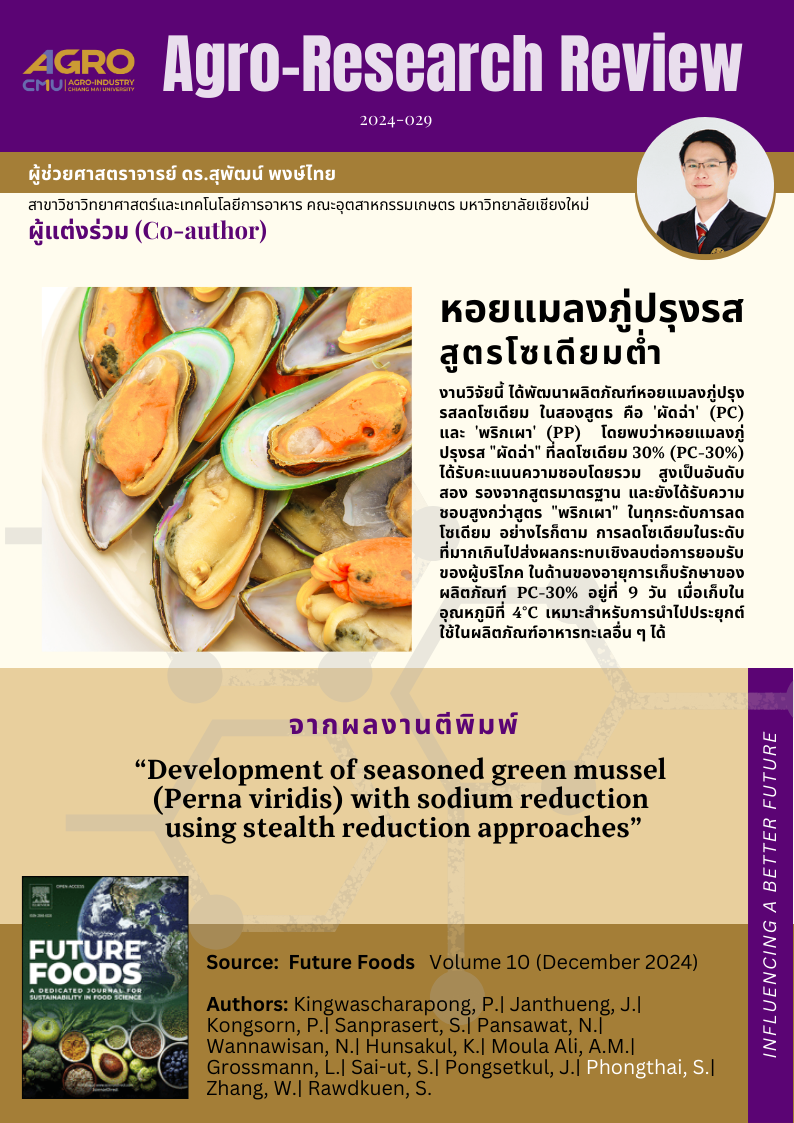
แนะนำงานวิจัย 2024-029 หอยแมลงภู่ปรุงรส สูตรโซเดียมต่ำ
งานวิจัยนี้ได้พัฒนาผลิตภัณฑ์หอยแมลงภู่ปรุงรสลดโซเดียม ในสองสูตร คือ 'ผัดฉ่า' (PC) และ 'พริกเผา' (PP) โดยพบว่าหอยแมลงภู่ปรุงรส "ผัดฉ่า" ที่ลดโซเดียม 30% (PC-30%) ได้รับคะแนนความชอบโดยรวมสูงเป็นอันดับสอง รองจากสูตรมาตรฐาน และยังได้รับความชอบสูงกว่าสูตร "พริกเผา" ในทุกระดับการลดโซเดียม อย่างไรก็ตาม การลดโซเดียมในระดับที่มากเกินไปส่งผลกระทบเชิงลบต่อการยอมรับของผู้บริโภค อายุการเก็บรักษาของผลิตภัณฑ์ PC-30% อยู่ที่ 9 วันเมื่อเก็บในอุณหภูมิ 4 °C ซึ่งเหมาะสำหรับการนำไปประยุกต์ใช้ในผลิตภัณฑ์อาหารทะเลอื่น ๆ ได้
This study developed two sodium-reduced seasoned green mussel products: "Pad-char" (PC) and "Prik-Pao" (PP). The results showed that the 30% sodium-reduced "Pad-char" product (PC-30%) received the second-highest overall liking score, just behind the standard formula, and was rated higher than the "Prik-Pao" product at all levels of sodium reduction. However, excessive sodium reduction negatively affected consumer acceptance. The shelf life of the PC-30% product was up to 9 days when stored at 4 °C, making it suitable for application in other seafood products.
Topic: Development of seasoned green mussel (Perna viridis) with sodium reduction using stealth reduction approaches
Authors: Kingwascharapong, P.| Janthueng, J.| Kongsorn, P.| Sanprasert, S.| Pansawat, N.| Wannawisan, N.| Hunsakul, K.| Moula Ali, A.M.| Grossmann, L.| Sai-ut, S.| Pongsetkul, J.| Phongthai, S.| Zhang, W.| Rawdkuen, S.
Abstract:
Excessive levels of sodium consumption over the recommended human daily intake level is a global issue. Developing novel low-sodium products to address this issue is challenging. Moreover, there is little research on the use of stealth reduction approaches in reduced sodium seasoned green mussel, representing an additional opportunity for advancement in developing novel products in the seafood processing industry. Thus, this study aimed to develop a seasoned green mussel (Perna viridis) product with a reduced sodium content. The study consisted of two parts: The first part studied two types mussel seasonings (‘Pad-char’; PC and ‘Prik-Pao’; PP) with various sodium reduction levels (30, 70, or 100 %). The difference in taste profiles was confirmed using an electronic tongue technique and consumer acceptance trial. Green mussels seasoned with PC were preferred over those seasoned with PP. Green mussels seasoned with PC at a 30 % sodium reduction level (PC-30 %) received the second highest overall liking score, following the standard, and had a sodium content of 623.80 mg/100 g. Furthermore, PC-30 % was rich in other essential nutrients such as protein and vitamin A. The second aim was to study the shelf-life of the PC-30 % products with storage at 4 ± 1ºC for 12 days. During storage, the PC-30 % sample developed a tough texture, as indicated by higher hardness and chewiness values, along with increased pH and total volatile-based nitrogen. The microbial loads indicated that the shelf-life of the PC-30 % product stored at 4 ± 1ºC was 9 days. This suggests that reducing sodium in mussels through seasoning is feasible while maintaining acceptable sensory scores, but shelf-life challenges must be addressed before bringing these products to market.
Keywords: Green mussel (Perna viridis); Low sodium; Product development; Reduced sodium
View at publisher: https://www.sciencedirect.com/science/article/pii/S2666833524001473?via%3Dihub
#อกมช. #agrocmu #CMU


